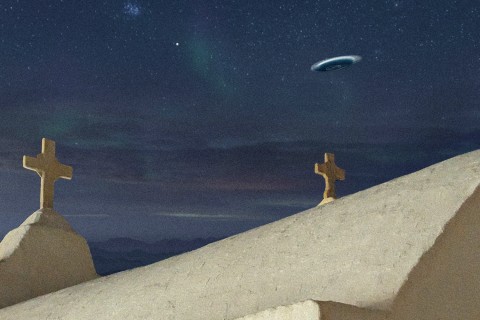Re-creation: Sharing in peace reclaimed from the ruins
Our children expect peculiar vacations. While their friends go to Disney World or the beach, we go to monasteries and rare book libraries, making a holiday out of castles and forests along the way and returning with odd bits of nature or history for our display case. Here, from a gravel driveway in the Cotswolds, is a fragment that might be a Neolithic arrowhead, and here, from a glade in one of Scotland’s oldest forests, is just the sort of flat stone you’d find in a fairy kitchen. Now that we’re back, the luster of our souvenirs is fading; they’re beginning to look like ordinary rocks. Yet they remind us of something ineffably precious, for they represent, at the very least, a universal longing to find renewal by re-creating the good things of the past.
Now that I think about it, the two highlights of our trip this summer were places where the work of re-creation is in full swing: a medieval monastery reclaimed from ruin by modern Benedictines, and the Kilns, C. S. Lewis’s home, reclaimed from 1970s remodeling by a group of indefatigable enthusiasts.
The Kilns is a two-story red brick bungalow of haphazardly connected small rooms on a suburban street some three miles from Oxford. We stopped to see the coots in the quarry pond where Lewis (“Jack” to friends) used to swim, then made our way along the narrow footpath, overgrown with flowering shrubs, to the ivy-garlanded front door. In the restored dining room, we chatted over elderberry cordial with two British Catholic scholars, one of whom was on hand to teach a C. S. Lewis Foundation seminar. The rest of the company was American evangelical: we found Americans in the sitting room, Americans in the converted garage library, Americans in the garden, all instantly recognizable by their happy, open faces.
In the kitchen, an antique coal-fueled cooker radiates heat incessantly, so that tea is always on offer. The blankets that covered the windows during wartime blackouts have given way to lighter curtains of the sort Lewis’s wife, Joy Davidman, introduced. The rugs into which Lewis and his brother, Warnie, habitually ground their cigarette and pipe ash are gone, but the ceilings have been deliberately painted nicotine yellow. We visited the room where Warnie died and gazed up at the outdoor staircase leading to Jack’s bedroom. We peered over the hedgerow where Joy would stand with her shotgun to discourage trespassers. It is all a bit fantastic, but one does feel that Lewis and his unusual family are present somehow and have accepted the intrusion.
Our other destination, where we had planned a long working holiday and family retreat, was Pluscarden Abbey, the only medieval monastery in Britain currently occupied by living, breathing, praying, laboring monks. Pluscarden sits in a sheltered glen in northeastern Scotland, surrounded by pasture lands, whiskey distilleries and fisheries. Here tattooed Pictish warriors once lived; on becoming Christian, they converted their sacrificial wells to baptismal fonts, having resolved to dunk their victims into heaven rather than hell. Here in 1230, Alexander II celebrated his ascendancy as king of the Scots by inviting Valliscaulian monks to begin a new foundation.
Eventually merging with a nearby Benedictine priory, Pluscarden carried on (despite occasional raids and fires) until the Scottish Reformation, when ownership passed into lay hands. The priory remained a picturesque ruin until 1948, when the last lay owner donated it to Prinknash Abbey and a band of Benedictine pioneers returned to camp under the stars in the roofless church and begin the hard work of reclamation. A micro-civilization arose from the ruins: without shortchanging the life of prayer, the monks became architects, handy-men, engineers, stained-glass makers, beekeepers, potato farmers and herdsmen, using modern methods to restore medieval structures. In their emphasis on cloistered contemplative life they were part of a larger postwar resurgence of classical Benedictinism, and in their liturgical practice they drew from the labors of great rebuilders like Dom Prosper Guéranger, the 19th-century abbot of Solesmes who shaped the modern revival of Gregorian chant in the process of restoring monastic life in France. Christian monasticism has always been a work of re-creation.
During our stay near Pluscarden, our older son, apprenticed to the community’s historian, deciphered marginalia from the personal Bible of the last surviving 16th-century monk; our younger son sampled monastic strawberries and visited the goats; my husband spent an afternoon with the bees. We attended all but the earliest hours of the Divine Office, listened to cows sound their bovine Compline in the late twilight, walked among foxgloves and ferns in the shade of giant elms, and watched rabbits dart among the wooden crosses of the monastic graveyard. All these impressions combined with the incessant “coo coooo coo cu-cu” of the wood pigeons to give us a sense of sharing in the peace of this place, a peace reclaimed, as always, from the ruins.
One thing is clear: authentic renewal doesn’t jettison the past; it reclaims it. We human beings are happier as re-creators than as innovators; we are homo reparans, as philosopher Elizabeth Spelman puts it in her book Repair. Damaged goods that we are, we constantly need to be reformed after the image of the God who made us. Fragile as our institutions are, they constantly need to be remade in fidelity to tradition. To be in contact with what is truly alive of the past is to hear the voice that says, “Behold, I make all things new.” To respond to that voice is to undertake the hard work of reclamation.





